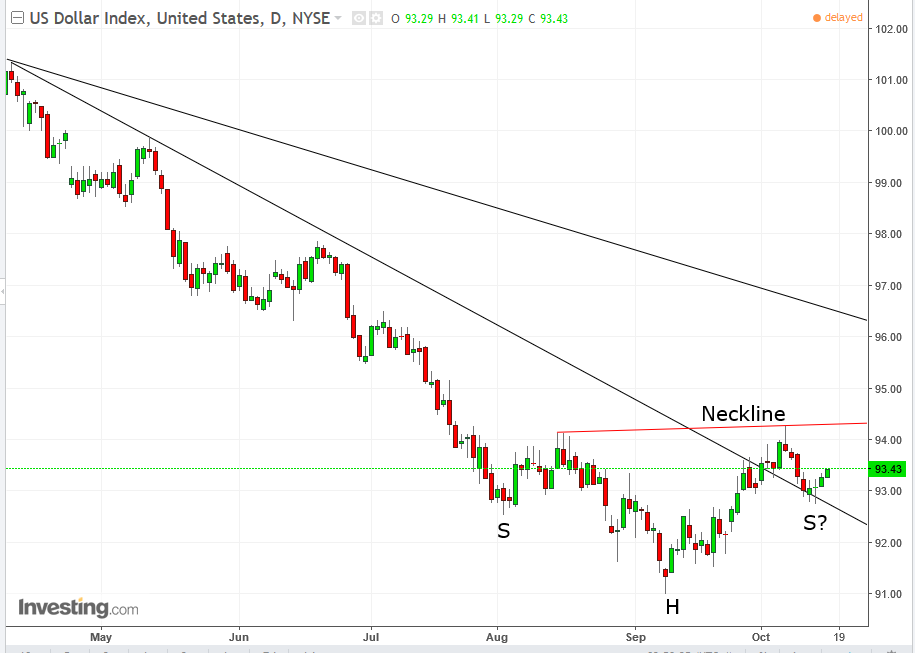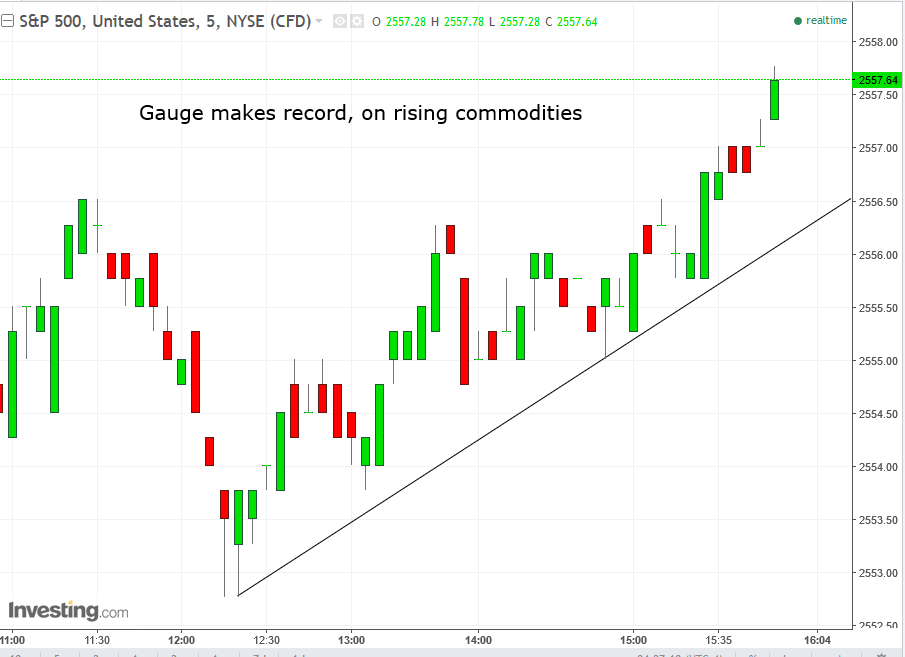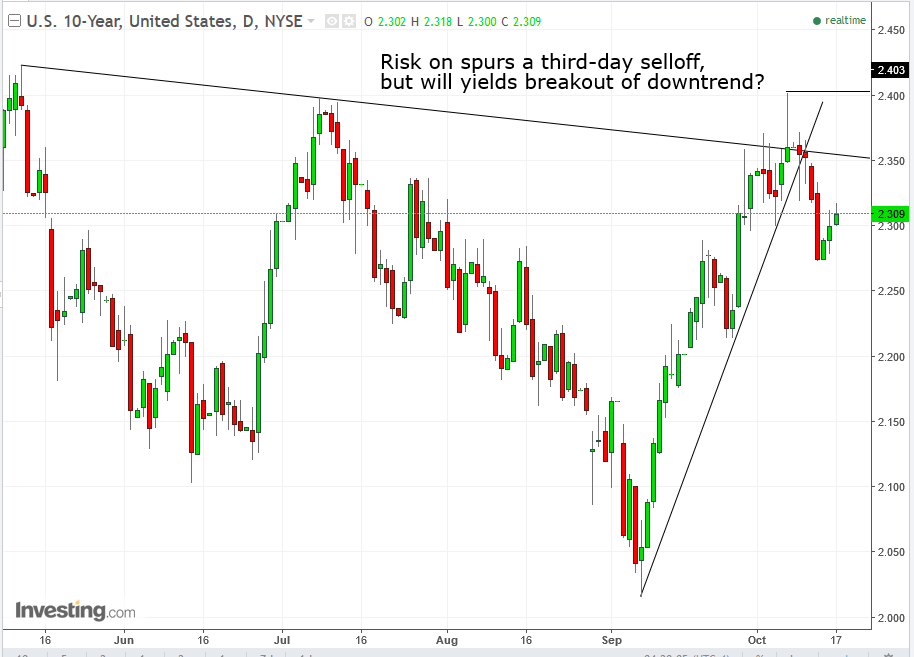by Pinchas Cohen
Key Events
- Chinese data and a higher expectation for rates, along with other FX weakness, bolsters the dollar
- Hawkish economist seen as Trump’s favorite to chair Fed
- Brexit negotiations stall, slowing pound’s 5-day winning streak
- Markets waiting to see who blinks first in Spain-Catalonia standoff
- US increases aggressive posture on fourth round of NAFTA negotiations
- S&P 500 Index hits new record, led by metals and oil.
Various global events have resulted in combined reactions from an assortment of assets. Here's how the price action has played out for the USD and SPX:
US Dollar
First, China’s producer price hit a 6-month high, supporting the narrative for global growth.
Second, Fed Chair Janet Yellen suggested in her comments at Sunday's G30 International Banking Seminar that inflation will pick up, reaffirming the narrative for global growth, which would require higher interest rates.
Third, speculation is mounting that Stanford University economist John Taylor is the leading candidate to be the next Fed chairperson, after reportedly making a highly favorable impression on US President Donald Trump. Taylor is known as an advocate for higher interest rates, which, if they happen, will provide a bigger payout for dollar holders.
Fourth, on news that Brexit negotiations have been breaking down, the pound slowed, ending its five-day winning streak.
Fifth, because of a standoff between Spain and the independence-seeking Catalonia, uncertainty undermined the euro/dollar.
Sixth, the US made aggressive demands during a fourth round of negotiations on the future of the North American Free Trade Agreement (NAFTA), weakening the Mexican peso versus the dollar.

The dollar advanced for a fourth day, confirming the breakout of the downtrend line since April 10. An advance past the previous, August 15 trough would suggest a bottom reversal, with a price target of 98.00 ahead.
S&P 500 Index
First, a higher expectation of faster global growth drove speculation that demand would rise for metals, key components for expanding building and infrastructure efforts. Chinese growth, in evidence via hard data, is particularly relevant. China is both the fastest growing global economy, as well as the biggest importer of construction metals.

Copper remained above $7,000 a metric ton, a 3-year high, after Palladium broke the $1,000 level, for the first time since 2001. Conjecture surrounding the current economic growth narrative predicts copper's price will continue higher.
Second, oil prices are rising on concerns of supply interruptions due to tensions between Iraq and its Kurdish minority.

Both sectors—energy and metals—led the S&P 500 to another record yesterday.
The Stoxx Europe 600 Index edged higher, after mixed trading in Asia earlier this morning. North Korea threatened a nuclear war could “break out any moment” which, not surprisingly, cast a pall on Asian trading.
Still, investors dumped gold in favor of the dollar, while South Korea's won led most emerging market currencies lower.
Up Ahead
- Among Fed speakers lined up this week are Philadelphia Fed President Pat Harker on Tuesday, and New York Fed President Bill Dudley and Dallas Fed President Robert Kaplan on Wednesday.
- U.S. economic data will include an array of September housing reports including Building Permits, Housing Starts and Existing Home Sales. Results will probably show the negative effects of Hurricanes Harvey and Irma on demand and building.
- China releases data early Thursday (late Wednesday night US) for GDP, Industrial Production and Retail Sales.
- The first full week of earnings season continues with major U.S. financial firms including Morgan Stanley (NYSE:MS) and Goldman Sachs (NYSE:GS) which report this morning, before the bell.
- Bank of England Governor Mark Carney appears before the U.K. Parliament’s Treasury Committee today, for the first time since June’s election.
Market Moves
Stocks
- Japan’s TOPIX closed 0.2 percent higher in Tokyo after gaining as much as 0.6 percent in earlier trading.
- Australia’s S&P/ASX 200 Index rose 0.7 percent
- South Korea’s KOSPI index was up 0.2 percent.
- Hong Kong’s Hang Seng Index and the Shanghai Composite Index were little changed.
- The Stoxx Europe 600 Index rose 0.1 percent as of 8:13 a.m. London time, hitting the highest in almost four months.
- The U.K.’s FTSE 100 declined less than 0.05 percent to its lowest in more than a week.
- Germany’s DAX dipped less than 0.05 percent.
- Spain’s IBEX Index fell 0.1 percent to the lowest point for the benchmari in a week.
- The MSCI Emerging Markets Index sank 0.2 percent, the first retreat in more than a week.
- S&P 500 Futures decreased less than 0.05 percent.
Currencies
- The Dollar Index gained 0.1 percent to the highest in a week.
- The euro declined 0.3 percent to $1.1766.

- The British pound increased 0.1 percent to $1.326.
- The Japanese yen climbed less than 0.05 percent to 112.17 per dollar.
Bonds

- The yield on 10-year Treasuries gained one basis point to 2.31 percent. The return of risk-on sentiment has spurred a third day of selling. Will yields break out of their downtrend?
- Germany’s 10-year yield increased one basis point to 0.38 percent.
- Britain’s 10-year yield rose one basis point to 1.336 percent.
- Spain’s 10-year yield decreased less than one basis point to 1.578 percent.
Commodities
- West Texas Intermediate crude dipped 0.2 percent to $51.77 a barrel.
- Gold dipped 0.4 percent to $1,290.40 an ounce, the weakest in a week.
- Copper decreased 0.8 percent to $3.21 a pound, the first retreat in more than a week.
